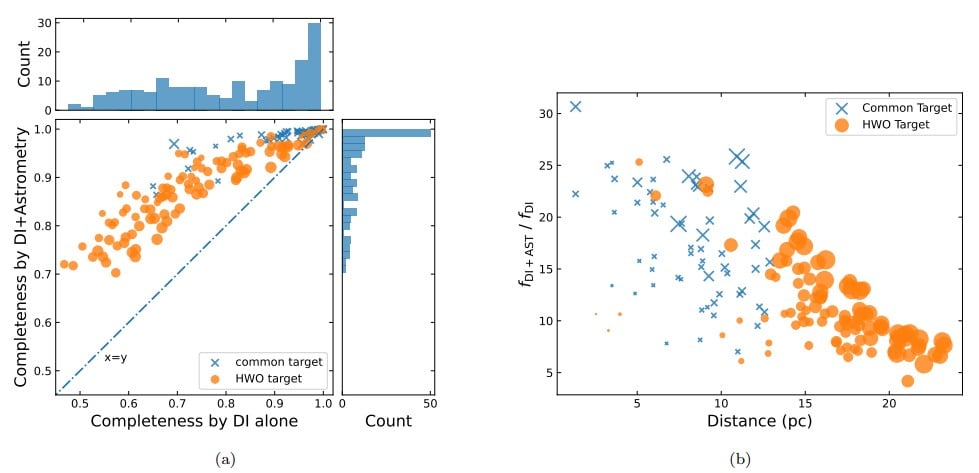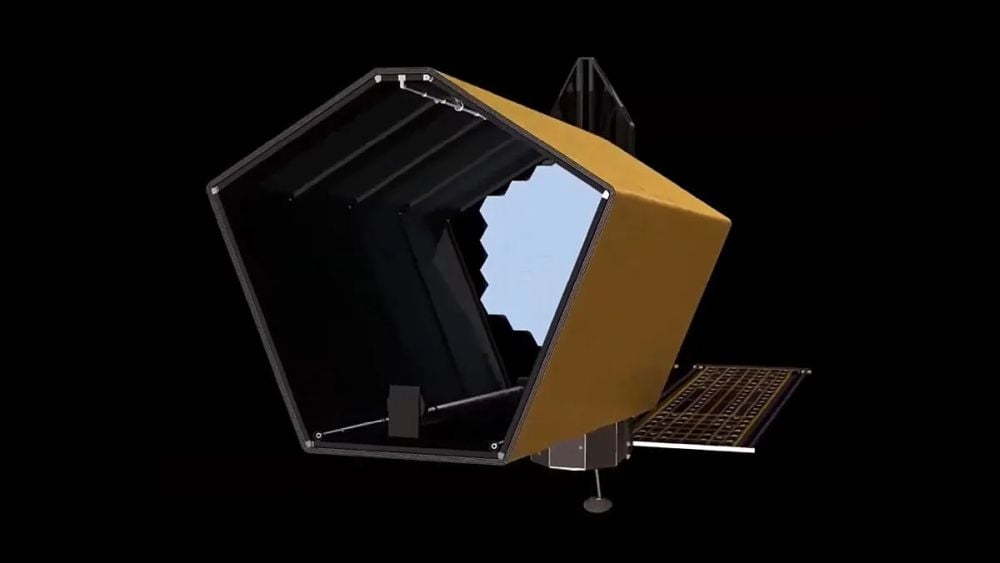If astronomy has a Holy Grail, it's another habitable world. To find one, NASA is working with partners to develop the Habitable Worlds Observatory (HWO). The HWO would be the first telescope built to detect Earth-like planets around Sun-like stars. China is building the Closeby Habitable Exoplanet Survey (CHES), and new research shows that by working together, HWO and CHES would amplify their results.
The HWO is sometimes called the 'Super Hubble'. It would have a 6—to 8-meter mirror that detects ultraviolet, optical, and infrared light. Unlike the Hubble, the HWO would have a coronagraph to block out starlight and make Earth-like planets easier to see. It would also work differently from missions like Kepler and TESS. Instead of using transits to detect exoplanets, HWO will image them directly. NASA thinks it could find 25 habitable worlds and use spectroscopy to look for chemical biosignatures in their atmospheres.
CHES works differently from the HWO. Like the ESA's successful Gaia mission, it will use astrometry to measure stars. The authors of a new paper show how CHES and the HWO can work together to achieve synergy.
The research is titled "Closeby Habitable Exoplanet Survey (CHES). IV. Synergy between astrometry and direct imaging missions of the Habitable World Observatory for detecting Earth-like planets." Chunhui Bao from the Chinese Academy of Sciences is the lead author.
"By combining the precise orbital constraints from the CHES with the imaging capabilities of HWO, we evaluate the improvements in detection efficiency, signal-to-noise ratio and overall planet yield," the authors write.
When the first exoplanets were detected, it was big news. Nowadays, detections don't generate the headlines they used to. They're still important, but not cutting-edge.
Space agencies have progressed from finding planets to characterizing them. This is how they're building a large knowledge base of exoplanets they can use to develop models and generate a deeper, more comprehensive understanding of the exoplanet population.
However, everyone understands that we really want to find Earth-like, habitable worlds. That means rocky planets in the habitable zones of Sun-like stars. According to the authors, the best way to do that is by combining the HWO's direct imaging with the CHES' astrometry.
Missions like HWO, the Nancy Grace Roman Space Telescope, and the Large Interferometer for Exoplanets all employ direct imaging with starshades. Although this method is powerful, it also has some drawbacks. An exoplanet's detectability varies over time due to its orbit and atmosphere. That means multiple observations are needed to achieve high completeness.
 *The Nancy Grace Roman Space Telescope is a next-generation optical and near-infrared telescope with a coronagraph and a spectrometer. Image Credit: GSFC/SVS*
*The Nancy Grace Roman Space Telescope is a next-generation optical and near-infrared telescope with a coronagraph and a spectrometer. Image Credit: GSFC/SVS*
Astrometry, on the other hand, enables exceptionally accurate and precise measurements of star positions over time. These measurements let astronomers measure exoplanet orbital parameters such as inclination, eccentricity, and period more accurately. That accuracy leads to a better understanding of planetary system architecture.
"When combined with direct imaging, astrometry enhances the robustness of exoplanet detections and reduces uncertainties in planetary characteristics, offering a more comprehensive view of each system," the authors explain.
The synergy between astrometry and direct imaging is a power waiting to be unlocked.
Among the various methods used for exoplanet discovery, direct imaging and astrometry provide unique advantages, particularly for detecting and characterizing planets in wider orbits," the authors write. "Direct imaging enables the spatial separation of a planet from its host star, facilitating studies of planetary atmospheres, climates, and surface compositions through spectral analysis.
 *This figure shows the overall completeness of every target in the left panel. The bottom-left sub-panel compares completeness by direct imaging alone (x-axis) with imaging+astrometry (y-axis). The top-left and bottom-right sub-panels give histograms of completeness in the two scenarios. The right panel shows the comparison of the benefit-to-cost ratio by imaging alone and imaging with astrometry. The orange points and blue crosses indicate targets for HWO only and common targets for HWO and CHES, respectively. The size of the points represents the distance from the center of the habitable zone. Image Credit: Bao et al. 2025*
*This figure shows the overall completeness of every target in the left panel. The bottom-left sub-panel compares completeness by direct imaging alone (x-axis) with imaging+astrometry (y-axis). The top-left and bottom-right sub-panels give histograms of completeness in the two scenarios. The right panel shows the comparison of the benefit-to-cost ratio by imaging alone and imaging with astrometry. The orange points and blue crosses indicate targets for HWO only and common targets for HWO and CHES, respectively. The size of the points represents the distance from the center of the habitable zone. Image Credit: Bao et al. 2025*
The authors say that the synergy between HWO and CHES produces better results.
"Our findings indicate that the detection completeness and efficiency of direct imaging can be improved through the synergy with future astrometric observations from CHES," they write. The detection efficiency enjoys a massive improvement of about 2 to 30 times. They estimate they could find more than 50 strong candidates for Earth-like worlds by using both telescopes.
Some of the synergy occurs because astrometry information from CHES reveals the best time to use HWO to image planets in any particular solar system. It takes some of the guesswork and randomness out of HWO observations. "By leveraging CHES's ability to constrain orbital elements and provide critical data on understanding planetary system architectures, HWO's observational resources can be optimally allocated," the authors explain.
Even though the JWST is taking a huge step forward by studying exoplanet atmospheres for signs of life, we're still only groping our way towards better knowledge of habitability. Many of its detections of potential biosignatures are just hints whose certainty suffers from multiple possible explanations.
The authors make a strong case that the Holy Grail discovery of an Earth-like habitable world may be closer than some think if we can leverage the synergy between HWO and CHES.
"With advancements in technology, the detection of habitable terrestrial planets in the optical band appears increasingly feasible in the coming decade," the researchers conclude.
 Universe Today
Universe Today
